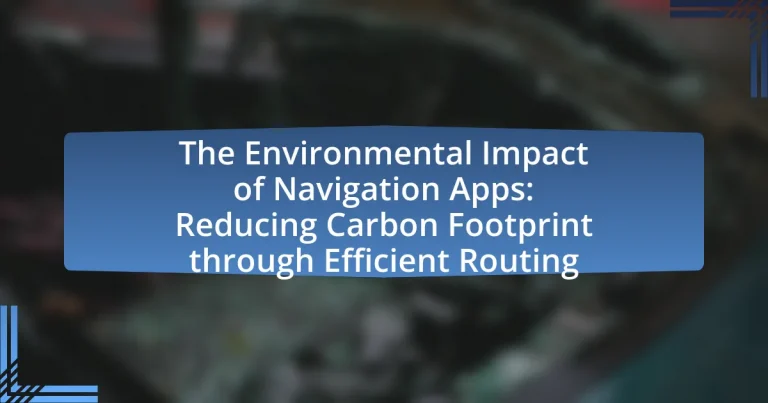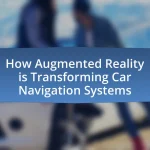Navigation apps play a crucial role in reducing the environmental impact of transportation by optimizing routes to decrease fuel consumption and greenhouse gas emissions. Studies indicate that these applications can lower travel distances by up to 20% and reduce vehicle emissions by approximately 10% through efficient routing and real-time traffic updates. Key features such as eco-routing, alternative transportation options, and historical data analysis enhance their effectiveness in promoting sustainable travel behaviors. The article explores the broader implications of navigation apps on environmental policy, urban planning, and user behavior, highlighting their potential to significantly contribute to global sustainability goals while addressing challenges such as user privacy and technological advancements needed for further eco-friendliness.
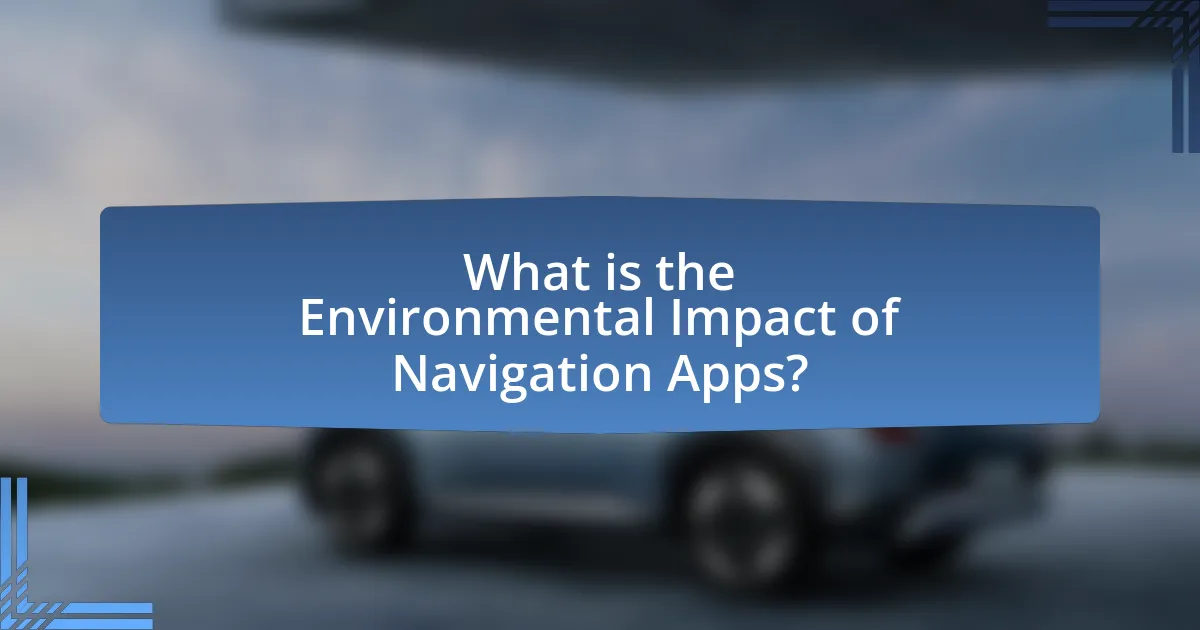
What is the Environmental Impact of Navigation Apps?
Navigation apps have a significant environmental impact by optimizing routes, which reduces fuel consumption and greenhouse gas emissions. Studies indicate that efficient routing can decrease travel distances by up to 20%, leading to lower carbon footprints for users. For instance, a report from the International Council on Clean Transportation found that navigation apps can reduce vehicle emissions by approximately 10% by minimizing idling and unnecessary detours. This efficiency not only benefits individual users but also contributes to broader environmental goals by promoting sustainable transportation practices.
How do navigation apps contribute to environmental sustainability?
Navigation apps contribute to environmental sustainability by optimizing routes to reduce fuel consumption and emissions. These applications analyze real-time traffic data and suggest the most efficient paths, which can lead to a significant decrease in travel time and distance. For instance, a study by the International Council on Clean Transportation found that using navigation apps can reduce fuel consumption by up to 20% in urban areas, thereby lowering greenhouse gas emissions. Additionally, by promoting carpooling and public transportation options, navigation apps further encourage sustainable travel behaviors, contributing to a decrease in the overall carbon footprint associated with transportation.
What are the key features of navigation apps that promote eco-friendliness?
Key features of navigation apps that promote eco-friendliness include route optimization for fuel efficiency, real-time traffic updates, and alternative transportation options. Route optimization minimizes travel distance and time, which reduces fuel consumption and emissions. Real-time traffic updates help users avoid congested areas, further decreasing idle time and emissions. Additionally, these apps often provide options for public transportation, cycling, or walking, encouraging users to choose greener modes of travel. Studies indicate that using such features can significantly lower carbon footprints associated with transportation.
How do user behaviors influenced by navigation apps affect carbon emissions?
User behaviors influenced by navigation apps significantly affect carbon emissions by optimizing routes and reducing travel distances. Navigation apps provide real-time traffic data and alternative routes, which can lead to shorter travel times and less idling, ultimately decreasing fuel consumption. For instance, a study by the International Council on Clean Transportation found that efficient routing through navigation apps can reduce vehicle emissions by up to 20% in congested areas. Additionally, users are more likely to choose eco-friendly transportation options, such as public transit or carpooling, when guided by navigation apps that highlight these alternatives. This shift in behavior contributes to lower overall carbon emissions from transportation.
Why is reducing carbon footprint important in transportation?
Reducing carbon footprint in transportation is crucial for mitigating climate change and improving air quality. Transportation accounts for approximately 29% of total greenhouse gas emissions in the United States, primarily from fossil fuel combustion. By minimizing carbon emissions, we can decrease the severity of global warming, which is linked to extreme weather events, rising sea levels, and biodiversity loss. Furthermore, reducing emissions enhances public health by lowering air pollutants that contribute to respiratory diseases. Efficient routing through navigation apps can significantly lower fuel consumption and emissions, demonstrating a practical approach to achieving these environmental benefits.
What are the environmental consequences of high carbon emissions in transportation?
High carbon emissions in transportation lead to significant environmental consequences, including climate change, air pollution, and biodiversity loss. The transportation sector is responsible for approximately 14% of global greenhouse gas emissions, primarily from fossil fuel combustion. These emissions contribute to the greenhouse effect, resulting in rising global temperatures and extreme weather events. Additionally, high carbon emissions release pollutants such as nitrogen oxides and particulate matter, which degrade air quality and pose health risks to humans and wildlife. Furthermore, the disruption of ecosystems occurs as climate change alters habitats, threatening species and reducing biodiversity.
How does transportation contribute to overall carbon footprint?
Transportation significantly contributes to the overall carbon footprint by being a major source of greenhouse gas emissions, particularly carbon dioxide. In 2019, the transportation sector accounted for approximately 29% of total greenhouse gas emissions in the United States, primarily from the combustion of fossil fuels in vehicles, airplanes, and ships. This reliance on fossil fuels leads to the release of millions of metric tons of CO2 annually, exacerbating climate change. Additionally, transportation emissions are projected to increase as global demand for mobility rises, further impacting the carbon footprint.
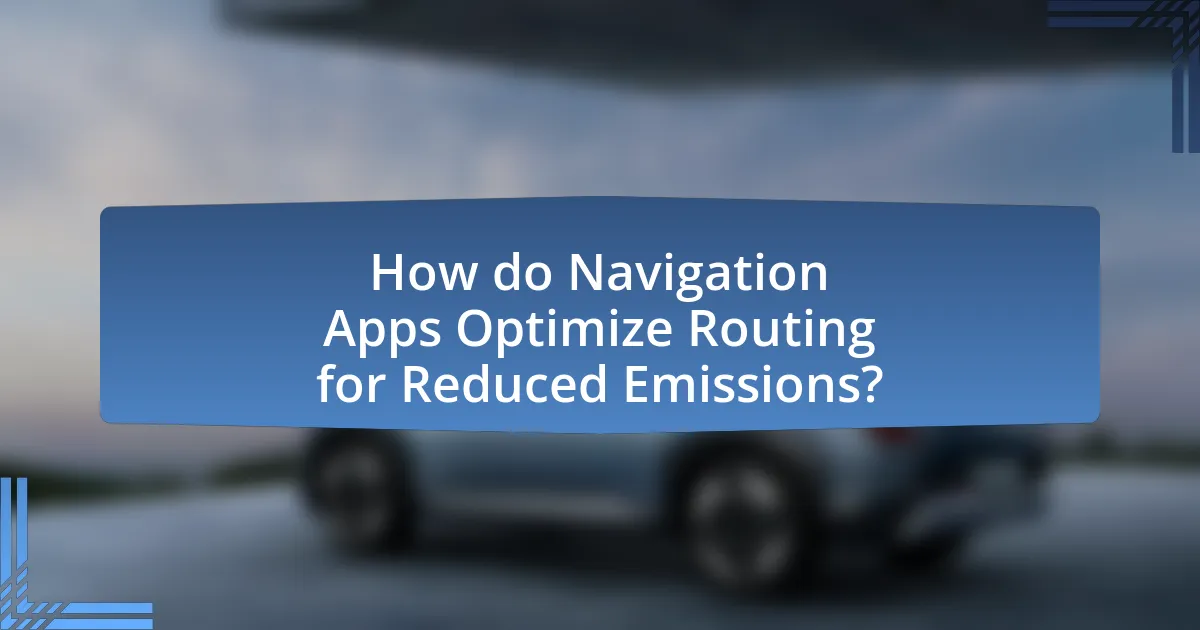
How do Navigation Apps Optimize Routing for Reduced Emissions?
Navigation apps optimize routing for reduced emissions by utilizing algorithms that analyze real-time traffic data, road conditions, and vehicle efficiency. These apps calculate the most efficient routes that minimize fuel consumption and travel time, thereby lowering carbon emissions. For instance, studies have shown that optimized routing can reduce emissions by up to 20% compared to traditional navigation methods, as they avoid congested areas and promote smoother driving patterns. Additionally, some navigation apps incorporate eco-routing features that specifically prioritize routes based on lower environmental impact, further contributing to emission reductions.
What routing algorithms do navigation apps use to minimize travel distance?
Navigation apps primarily use Dijkstra’s algorithm and A* (A-star) algorithm to minimize travel distance. Dijkstra’s algorithm efficiently finds the shortest path in a graph by exploring all possible paths and selecting the one with the least cost, making it suitable for static maps. The A* algorithm enhances this by incorporating heuristics, allowing it to prioritize paths that are likely to lead to the destination more quickly, thus reducing overall travel distance. Both algorithms are foundational in routing applications, as they enable users to navigate efficiently, ultimately contributing to reduced fuel consumption and lower carbon emissions.
How do real-time traffic updates enhance routing efficiency?
Real-time traffic updates enhance routing efficiency by providing drivers with immediate information about current road conditions, allowing for dynamic route adjustments. This capability reduces travel time by enabling navigation systems to avoid congested areas, accidents, or road closures. For instance, studies show that navigation apps utilizing real-time data can decrease travel times by up to 30%, leading to less fuel consumption and lower emissions. By optimizing routes based on live traffic conditions, these updates contribute to more efficient driving patterns, ultimately reducing the carbon footprint associated with transportation.
What role does historical data play in optimizing routes?
Historical data plays a crucial role in optimizing routes by providing insights into past traffic patterns, travel times, and road conditions. This data enables navigation apps to predict future traffic scenarios more accurately, allowing for the selection of the most efficient routes. For instance, studies have shown that using historical traffic data can reduce travel time by up to 20%, as it helps identify recurring congestion points and alternative paths that may be less congested at specific times. By leveraging this information, navigation systems can minimize fuel consumption and emissions, contributing to a lower carbon footprint.
How do navigation apps compare to traditional navigation methods in terms of efficiency?
Navigation apps are generally more efficient than traditional navigation methods. They utilize real-time data, including traffic conditions and route optimization algorithms, to provide the fastest routes, which can reduce travel time by up to 30% compared to paper maps or verbal directions. Studies show that users of navigation apps experience fewer delays and can adapt their routes dynamically, leading to lower fuel consumption and reduced carbon emissions. For instance, a study by the University of California found that navigation apps can decrease overall driving distances, contributing to a significant reduction in greenhouse gas emissions.
What are the limitations of traditional navigation methods regarding carbon footprint?
Traditional navigation methods have significant limitations regarding carbon footprint, primarily due to their reliance on less efficient routing and lack of real-time data. These methods often use pre-defined maps and routes that do not account for current traffic conditions, leading to longer travel times and increased fuel consumption. For instance, studies indicate that traditional navigation can result in up to 20% more fuel usage compared to optimized routing systems that adapt to real-time traffic and road conditions. Additionally, traditional methods do not incorporate eco-friendly routing options, which can minimize emissions by suggesting paths that avoid congested areas or prioritize public transportation.
How do user experiences differ between navigation apps and traditional methods?
User experiences differ significantly between navigation apps and traditional methods, primarily due to real-time data integration and user interactivity. Navigation apps provide dynamic route adjustments based on live traffic conditions, which enhances efficiency and reduces travel time, while traditional methods, such as paper maps or verbal directions, lack this adaptability and often lead to longer, less efficient routes. For instance, a study by the American Automobile Association found that GPS navigation can reduce travel time by up to 20% compared to traditional navigation methods, demonstrating the tangible benefits of using technology for navigation.
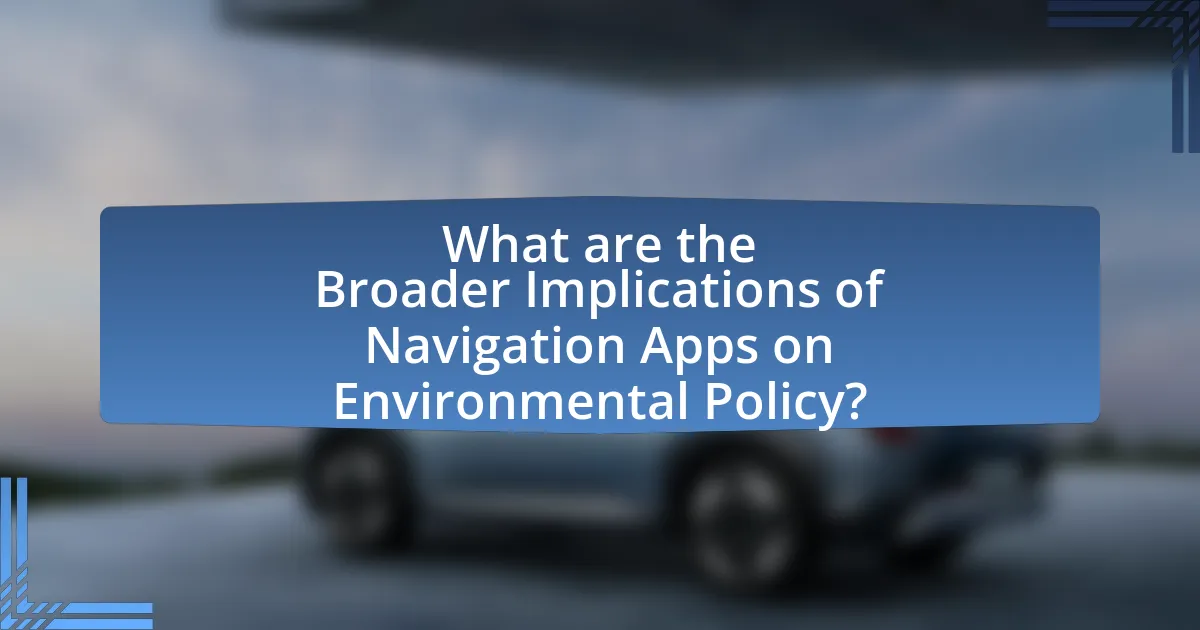
What are the Broader Implications of Navigation Apps on Environmental Policy?
Navigation apps significantly influence environmental policy by promoting efficient routing that reduces fuel consumption and greenhouse gas emissions. These applications optimize travel routes, leading to shorter distances and less idling time, which directly contributes to lower carbon footprints. For instance, a study by the International Council on Clean Transportation found that navigation apps can reduce vehicle emissions by up to 10% through improved route planning. This reduction in emissions can inform policymakers to prioritize the integration of technology in transportation strategies, encouraging investments in smart infrastructure and sustainable urban planning. Consequently, the widespread use of navigation apps can drive legislative changes aimed at enhancing environmental sustainability and reducing the overall impact of transportation on climate change.
How can navigation apps influence urban planning and infrastructure development?
Navigation apps can significantly influence urban planning and infrastructure development by providing real-time data on traffic patterns and user behavior. This data enables city planners to identify congestion hotspots and optimize road layouts, leading to more efficient traffic flow. For instance, a study by the University of California, Berkeley, found that cities utilizing navigation app data could reduce traffic congestion by up to 20%, allowing for better allocation of resources in infrastructure projects. Additionally, insights from navigation apps can inform the placement of public transportation routes and bike lanes, promoting sustainable urban mobility and reducing carbon emissions.
What policies can be implemented to encourage the use of eco-friendly navigation apps?
To encourage the use of eco-friendly navigation apps, governments can implement policies that provide financial incentives for users and developers. For instance, tax rebates or subsidies for users who choose eco-friendly routing options can motivate individuals to select these apps over traditional navigation tools. Additionally, grants for developers creating innovative features that promote sustainability, such as real-time emissions tracking or alternative transportation options, can enhance the appeal of eco-friendly navigation apps. Research indicates that financial incentives significantly influence consumer behavior, as seen in studies showing that subsidies for electric vehicles increased adoption rates by over 50%.
How do navigation apps align with global sustainability goals?
Navigation apps align with global sustainability goals by optimizing routes to reduce fuel consumption and greenhouse gas emissions. These applications utilize real-time traffic data and algorithms to identify the most efficient paths, which can lead to significant reductions in travel time and distance. For instance, studies indicate that efficient routing can decrease carbon emissions by up to 20% for urban driving, contributing to cleaner air and lower overall environmental impact. By promoting carpooling and public transportation options, navigation apps further support sustainable mobility practices, aligning with initiatives aimed at reducing urban congestion and enhancing public transit usage.
What challenges do navigation apps face in promoting environmental sustainability?
Navigation apps face significant challenges in promoting environmental sustainability, primarily due to the reliance on real-time data and user behavior. These applications often prioritize the fastest routes, which can lead to increased fuel consumption and emissions, contradicting sustainability goals. For instance, a study by the International Council on Clean Transportation found that navigation systems that optimize for speed rather than fuel efficiency can increase greenhouse gas emissions by up to 20%. Additionally, the integration of electric vehicle (EV) charging stations into routing algorithms remains limited, hindering the support for sustainable transport options. Furthermore, user preferences for convenience over eco-friendliness complicate the implementation of greener routing options, as users may opt for routes that are not the most environmentally friendly.
How can user privacy concerns impact the effectiveness of navigation apps?
User privacy concerns can significantly impact the effectiveness of navigation apps by limiting user engagement and data sharing. When users are apprehensive about how their location data is collected and utilized, they may opt out of sharing critical information that enhances the app’s functionality, such as real-time traffic updates and personalized routing suggestions. A study by the Pew Research Center found that 81% of Americans feel they have little to no control over the data collected about them, which can lead to decreased usage of navigation apps that require location tracking for optimal performance. Consequently, reduced data availability can hinder the app’s ability to provide accurate and efficient routing, ultimately affecting its overall effectiveness in reducing carbon footprints through optimized travel routes.
What technological advancements are needed to enhance the eco-friendliness of navigation apps?
Technological advancements needed to enhance the eco-friendliness of navigation apps include the integration of real-time traffic data, machine learning algorithms for optimized routing, and the incorporation of electric vehicle (EV) charging station locations. Real-time traffic data allows apps to provide the most efficient routes, reducing idle time and fuel consumption. Machine learning algorithms can analyze user behavior and traffic patterns to suggest routes that minimize carbon emissions. Additionally, including EV charging stations supports the transition to electric vehicles, further decreasing the overall carbon footprint associated with navigation. These advancements collectively contribute to more sustainable travel options and align with environmental goals.
What practical steps can users take to maximize the environmental benefits of navigation apps?
Users can maximize the environmental benefits of navigation apps by selecting eco-friendly routing options that prioritize fuel efficiency and minimize travel distance. Many navigation apps offer settings that allow users to choose routes based on the least carbon emissions or shortest travel time, which can significantly reduce fuel consumption. For instance, a study by the International Council on Clean Transportation found that optimizing routes can decrease fuel use by up to 20%. Additionally, users should consider carpooling features within these apps to reduce the number of vehicles on the road, further lowering overall emissions. By actively utilizing these features, users contribute to a reduction in their carbon footprint while benefiting from more efficient travel.
